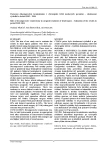-
Medical journals
- Career
TREATMENT OF UNSTABLE MANDIBULAR FRACTURES
Authors: Jiří Stránský; Oldřich Res; Lenka Bialková
Authors‘ workplace: Department of Oral and Maxillofacial Surgery University Hospital Ostrava ; Klinika ústní, čelistní a obličejové chirurgie FN Ostrava
Published in: Úraz chir. 16., 2008, č.2
Overview
INTRODUCTION:
The aim of this study is to present experience of the department in treatment of unstable fractures of mandible. The face is the place where many important functions of everyday life are located and for this reason it presents an important area from the traumatology point of view. The most exposed part is the mandible. The traditional way of fixation of mandibular fractures is intermaxillar fixation. The drawbacks of this method lead to a growing popularity of various types of osteosynthesis.MATERIAL AND METHODS:
The fixation with monocortical miniplates has become the standard of treatment This method is suitable for most mandibular fractures, however, it does not present satisfactory results in cases of some more complicated, unstable injuries. One of the possible ways of treating such fractures is rigid, bicortically fixed osteosynthesis, supplemented with a monocortical plate for higher stability.RESULTS AND DISCUSSION:
A total of 218 patients with fractures of the mandible hospitalised at the Department of Dental and Facial Surgery between 2005 and 2006. Almost a half of the cases (103) were treated surgically, with osteosynthesis. Twelve of these patients had a rigid osteosynthesis of the mandible, no cases of surgical treatment failure were reported.CONCLUSION:
The authors consider the bicortical rigid osteosynthesis of the mandible to be a suitable alternative for the treatment of serious, unstable fractures of the mandible, including in-juries such as multiple fractures, splintery fractures, significantly dislocated fractures, fractures of atrophic mandible or infected fractures. The findings of this study suggest positive outcomes of this type of treatment.Key words:
fracture of the mandible, „miniplate“, rigid osteosynthesis.
Sources
1. WARD BOOTH, P., SCHENDEL, S.A., HAUSaMEN, J.E. et al. Maxillofacial surgery. Edinburgh: Churchill Livingstone. 1999, 1748 p.
2. BUSCH, R.F. Mandibular osteosynthesis with intraoral miniplates and cortical bone screws. Ear Nose & Throat J. 1995, 74, 814–817.
3. CHAMPY, M., LODDÉ, J.P., SCHMITT, R. et al. Mandibular osteosynthesis by miniature screwed plates via a buccal approach. J Max-fac Surg. 1978, 6, 14–21.
4. JOOS, U., PIFFKO, J., MEYER, U. Neue Aspekte in der Versorgung von Unterkieferfrakturen. Mund Kiefer Gesichts Chir. 2001, 5, 2–16.
5. KUNZ, C., HAMMER, B., PREIN, J. Frakturen des zahnlosen atropischen Unterkiefers. Frakturversorgung und Komplikationen. Mund Kiefer Gesichts Chir 2001. 5, 227–232.
8. PREIN, J. et al. Manual of internal fixation in the craniofacial skeleton : techniques recommended by the AO/ASIF-Maxillofacial Group. Berlin; New York: Springer 1998, xiv, 227 p.
9. RASSEM, A. O historickém vývoji diagnostiky a terapie zlomenin obličejových kostí. Choroby hlavy a krku. 2005, 1, 5–8.
10. SIDDIQUI, A., MARKOSE, G., MOOS, K.F. et al. One miniplate versus two in the management of mandibular angle fractures: A prospective randomised study. Brit J Oral Maxillofac Surg. 2007, 45, 223–225.
11. SYROVÁTKA, J., MICHNA, P., GREGUŠOVÁ, E., HODAN, R. Použití skob s „tvarovou pamětí“ při osteosyntéze zlomenin dolní čelisti. Česká stomatologie. 2005, 1, 26–29.
Labels
Surgery Traumatology Trauma surgery
Article was published inTrauma Surgery

2008 Issue 2
Most read in this issue- TREATMENT OF UNSTABLE MANDIBULAR FRACTURES
- Maxillofacial injuries in University hospital Ostrava
- Role of decompressive craniectomy in surgical treatment of head injury - evaluation of the results in period 2002-2004
Login#ADS_BOTTOM_SCRIPTS#Forgotten passwordEnter the email address that you registered with. We will send you instructions on how to set a new password.
- Career

